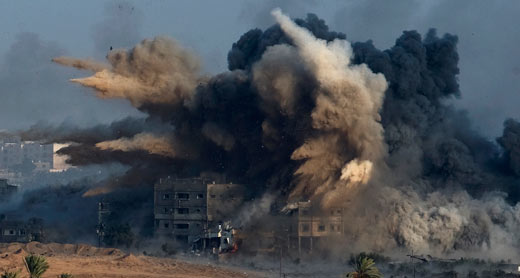
A house bombed in Gaza. Ronen Zvulun, Reuters, 26 July 2014

The inevitable outcome of bombing homes and inhabited areas in Gaza
From 8 July 2014, when the recent bout of fighting in Gaza began, through 10 August 2014, at least 1,767 residents of the Gaza Strips were killed. This according to initial figures B'Tselem collected in the course of the fighting. This number includes 431 individuals under the age of 18 (including one of whom it is known that he took part in the hostilities); 200 women under the age of 60; and 85men and women over 60.
To the best of B'Tselem's knowledge, at least 70 residential buildings were bombed or shelled, with three or more relatives from a single family killed in each case. A total of 542 persons, mostly minors and women, were killed in these 70 homes: 242 minors; 126 women under the age of 60; and 25 men and women over 60.
Airstrikes on homes formed a major part of the policy implemented by the Israeli military from the start of this bout of fighting in Gaza. The scope of these airstrikes as well as the length of time that they persisted indicate that they were likely authorized by senior military and political officials, and were also granted advance sanction by the Military Advocate General Corps and the Ministry of Justice.
As part of that policy, homes were bombed every day, more and more civilians were killed and entire families were obliterated. Even compared to previous bouts of fighting in Gaza, the number and frequency of incidents this time around was unusually high, with many people killed each time, mostly civilians who did not take part in the hostilities. For instance, on 20 July 2014 an airstrike on a building in Bani Suheila – a neighborhood northeast of Khan Yunis – killed 26 people from the Abu Jame' family, including 19 minors and five women; the bombing of a residential buildings on 26 July 2014 killed 20 members of the a-Najar family, including 12 minors, six women, and a 60-year-old man; an airstrike on an apartment building in Khan Yunis on 29 July 2014 killed 35 people from four families – including 18 minors and eight women.
Nevertheless, to date – either during the fighting or subsequently – no official Israeli authority has troubled to offer an explanation for so many civilian fatalities, except with regard to a few cases in which an explanation was demanded by international bodies. It may be that the government and military consider these results reasonable and proportionate, or perhaps they see no need to explain to the public how and why so many people were killed in Gaza. Be that as it may, their silence implies that such extensive harm to civilians is seen as legitimate.
The grave consequences lend a hollow ring to Israel's repeated claims that it has no intention of harming civilians. The massive bombardments of civilian locations were the rule rather than the exception in the last operation, routinely killing dozens of people a day. Whoever authorized the strikes must have known that they would result in many civilian fatalities, yet the bombardments continued day after day and even intensified. Authorizing attacks from the air, sea and artillery fire at heavily populated civilian areas and specific homes, constitutes willfully ignoring the inevitable killing of civilians – men, women and children – who did not take part on in the hostilities.
But Hamas is to blame – right?
Israeli officials – military and otherwise – repeatedly state that the military is doing all it possibly can to minimize harm to civilians. However, they argue, Hamas is endangering the lives of the civilian population, and is therefore solely responsible for the consequences of Israel’s actions: people killed, injured or displaced, and homes and infrastructure ruined.
In this vein, in response to a joint letter by several human rights organizations, including B'Tselem, the Israeli Attorney General wrote on 5 August 2004 to Att. Tamar Feldman of Israeli NGO ACRI (Association for Civil Rights in Israel) that Israel is committed to upholding the law, but "terrorist organizations make cynical, criminal use of the civilian population as human shields in the face of IDF activity. In this reality, unfortunately, even legal, proportionate attacks carried out in keeping with international law may cause unintentional and unwanted harm to civilians and civilian property". Similarly, Israeli Chief of Staff Benny Gantz said in a press conference on 6 August 2014 that "the result in Gaza has been devastation, and the tragic blame lies with Hamas leaders, who operated from within concentrations of population".
Hamas did, indeed, violate international humanitarian law (IHL) during the fighting: its operatives fired at civilians and civilian locations within Israel, concealed weapons in civilian buildings and institutions in the Gaza Strip, and even fired from locations close to civilian structures or from within such structures. In doing so, Hamas endangered civilians within Gaza, forcing the civilian population to be a part of the sphere of fighting. Such conduct is unlawful, as B'Tselem has repeatedly stated and wishes to underscore once more.
However, Israel is wrong in shirking responsibility for the consequences of its actions and in laying them at Hamas' door. Israel and Hamas are each responsible for their own actions. The Israeli premise is faulty, on legal, factual and moral grounds:
From a legal standpoint, IHL – which stipulates rules of war for exactly such circumstances – actions during hostilities are not dependent on "reciprocity": one party's breach of the law does not give the other party carte blanche to do so. Israel is well aware of this issue. Therefore, along with depositing responsibility at Hamas’ doorstep, Israeli states it carefully abides by IHL. Those statements, however, issued by government and military officials, do not hold water:
- Israel states that all the attacks on Gaza were only aimed at military targets – yet it defines "military target" so broadly that the term loses all meaning. In the last operation, the term came to encompass civilian buildings, such as the family homes of Hamas military operatives. This violates the fundamental IHL principle of distinction.
- Israel states that all its strikes in Gaza were proportionate, and that the fact that civilians were killed does not in itself contradict that. Yet after dozens of strikes, each killing many uninvolved civilians, while Israel did not prove or even claim military gains significant enough to render such damage proportionate, this argument is no longer tenable. This conduct violates another central tenet of IHL – the principle of proportionality.
- Israel states that the military warned residents in Gaza prior to attacks – but issuing warnings is not enough in itself. True, hundreds of thousands of Gazans – including children, the elderly and sick individuals – were given warning that they should leave their homes. Yet, if there is nowhere to go, when there in not always enough time to complete the evacuation, and when traveling is unsafe – as many Gazans reported in recent weeks – it is unreasonable to expect the entire civilian population to evacuate. Indeed, many civilians did not leave their homes, either for fear or because they could not. Under such circumstances, Israel should not have assumed that all civilians have indeed left their homes and fully heeded its warnings.
IHL places important restrictions on combatants, in order to minimize harm to civilians. While Israel argues that it operates within these parameters, in actuality it shifts them to its convenience, ignoring accepted interpretations of the law. The practical implication is sending the military to act in accordance with an unlawful policy, inevitably resulting in extensive damage to civilians in Gaza.
As for the facts: Israel did not bomb only those places that it claims Hamas used for military activity but also civilian locations, including dozens of homes with families in them, killing many civilians. As yet, the military has not provided proof that it attacked only targets used by Hamas' military branch. Unlike previous incidents, almost no attempt has been made to explain the high civilian death toll. Instead, officials made only general claims about Hamas' conduct and published footage of several instances in which Hamas concealed rockets at civilian sites, instances in themselves of unacceptable and unlawful conduct.
Morally: because civilians have paid a terrible price for this policy. Initial data gathered during the operation indicate that in four weeks of bombardment and shelling, more than 600 minors, women, and men over 60 were killed. It is certain that none of these persons took part in the hostilities nor did they threaten Israeli civilians or targets. Almost half a million people (more than a quarter of Gaza's populace) were displaced on short notice, leaving behind all most of their belongings. It is unclear how many of them will have homes to return to. This is the direct result of the policy led by senior Israeli officials, who considered it a legitimate response to rocket fire into Israel and the threat of infiltration into Israel via tunnels. These officials must have had the capacity to predict such grave consequences, and the moral responsibility for choosing this course of action lies with them.
Hamas does fire at civilians, does operate within its own civilian populace, and does conceal weapons in civilian locations. These actions are breaches of the law and Hamas must be held accountable for such violations. However, Hamas’ responsibility does not absolve Israel of responsibility for its own actions. Hamas is not – and cannot be – responsible for the extreme damage that Israel caused civilians in Gaza. Holding Hamas responsible for Israel's actions is tantamount to freeing Israel of any restrictions in its response, no matter how horrendous, to violations of the law by Hamas. This position is unjustifiable, either morally or legally: the responsibility for the harsh consequences of Israel's policy in the last month lies with Israel's government and top military commanders who authorized it, despite the foreseeable horrific results.
No comments:
Post a Comment